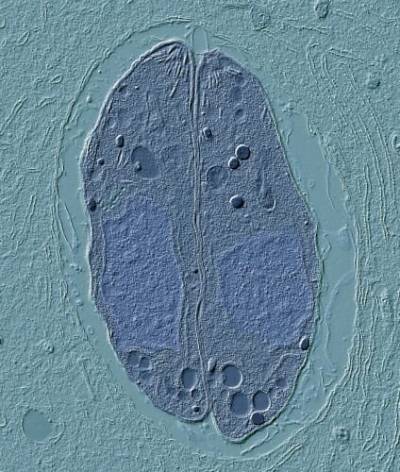In the intestines of people and most other animals, linoleic acid is metabolized with the help of an enzyme known as delta-6-desaturase or D6D. Felines, it turns out, are the only mammals that lack D6D activity in their intestines, providing an environment rich in linoleic acid, which apparently is the molecular key that helps Toxo achieve sexual maturity.
Knoll speculates that because cats evolved in a desert environment and to compensate for scarce food resources they ramped down production of D6D. “They basically shut off expression of this enzyme so all their lipids go into energy,” Knoll says.
Working in mice, Knoll’s team used an inhibitor to suppress the D6D enzyme and supplemented the mouse diet with linoleic acid, thereby achieving Toxo sex in a rodent model. Importantly, the treated rodents poop out Toxo oocysts, just like cats although not as many, providing an alternative laboratory model to study Toxo.
The new model is now critically important as the USDA laboratory that supplied Knoll’s team with the cat feces they needed for their work was shut down after anti-research activists pressured Congress. “This work wouldn’t have been possible without cat poop,” says Knoll, of the cat waste rich in Toxo oocysts.
While promising, the approach used by Knoll is not practical for many labs because the drug used to tamp down the linoleic acid metabolizing D6D enzyme is costly, on the order of $300 per mouse. “That’s not something most labs are able to do,” says the Wisconsin researcher. “And the mouse doesn’t poop out as many oocysts as a cat.”
Knoll hopes to address part of the issue by using CRISPR technology to make a knockout mouse that does not produce the D6D enzyme in its intestines. “We’ll basically be making a cat-mouse,” says Knoll. “It will help get around the issue of cost.”
However, developing the new mouse model will take at least a year, meaning research on the parasite and ways to control it in people and animals will be stalled. And that is worrisome, Knoll adds, as a new strain of Toxo recently emerged in an outbreak in Brazil, and unlike the familiar strains of Toxo, the new strains emerging in South America seem to be having direct health effects on their human hosts, including the blinding disease retinitis and disorders of the nervous system.


